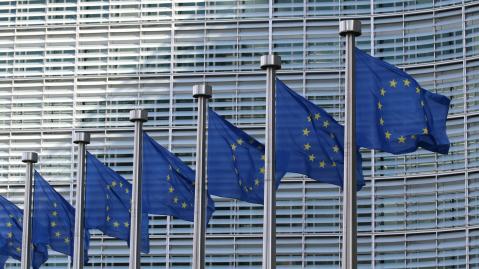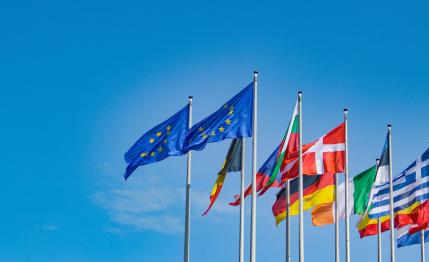
EU proposes major reforms to ETS and new policies to meet 2030 target
On 14 July 2021, the European Commission released a sweeping set of policy proposals spanning all major sectors of the economy aimed at achieving its 2030 climate target of at least 55% below 1990 levels and setting the bloc on a path to net zero by mid-century.
The proposal for the Revision of the EU Emission Trading System presents a milestone update of the EU ETS, with increased ambition reflected in a one-off reduction to the cap and a more ambitious annual decline; a separate fuel ETS for buildings and transport; strengthened benchmarks and leakage provisions, including a carbon border adjustment mechanism (CBAM); updated parameters of the Market Stability Reserve (MSR); and new regulations around revenue use aimed to address distributional effects and spur innovation.
The Commission’s proposal builds on the 2030 Climate Target Plan, impact assessments, and stakeholder consultation rounds. It would place emissions trading at the heart of the EU’s decarbonization agenda. It has yet to go through the EU’s ordinary legislative procedure before entering effect in its final form in the coming years, a process requiring approval — likely with some amendments — by the Council of the EU and the European Parliament.
Alongside reforms to the EU ETS, the Commission also published proposals for updating other major legislative cornerstones of the EU’s energy and climate policy under the Green Deal. These include:
- increased climate targets assigned to Member States for the non-ETS sectors under the Effort Sharing Regulation (ESR)
- climate neutrality in land use, forestry, and agriculture by 2035
- increasing the target under the Renewable Energy Directive to 40% in final energy consumption from 32%
- more ambitious energy efficiency targets
- stronger CO2 standards for the car fleet
- major expansion of low-carbon infrastructure for transport
- promoting measures for increased uptake of alternative fuels
- aligned energy taxation with EU energy and climate policies.
Cap trajectory
Emission reductions for the ETS would be ramped up from 43% to 61% below 2005 levels by 2030, placing a higher burden on the ETS in delivering the 2030 Climate Target Plan. To achieve this, the proposal envisages a near doubling of the annual cap decline factor of the system from 2.2% to 4.2% starting the year after the measure comes into effect. Since the decision-making process may still take several years, the measure would be accompanied by a downward rebasing of the cap to ensure the increased reduction factor applies from 2021 retroactively. The exact quantity will be determined upon implementation.
Free allocation
In parallel, the Commission has proposed measures to cut free allocation in line with the reduced overall allowance budget. Under existing measures of Phase 4 of the EU ETS, sectors that are not included in the EU's leakage list based on emissions intensity and trade exposure will no longer receive free allowances by 2030. The proposal would see remaining free allocation to energy-intensive and trade-exposed sectors covered by the CBAM phased out by 2035 at a rate of 10% per year starting 2026 — placing a gradually increasing role on the envisaged CBAM to level the playing field with some carbon-intensive goods from external markets. The proposal does not include a phasedown of free allocation for the remaining industrial sectors on the leakage list that are not included among the initial CBAM sectors, such as refineries and chemicals. Free allocation to the aviation sector, currently at 82% following the application of separate provisions to airlines, would also decrease more rapidly in favor of auctioning in the coming years.
Furthermore, product benchmarks, a key component in determining free allocation levels to covered entities, would be made more stringent with more ambitious annual reduction rates from 2026 onwards, decreasing overall free allocation to energy-intensive producers at a faster pace. In addition, the scope of benchmarks would be broadened — moving away from narrow product definitions that exclude low-carbon technologies — to reward producers shifting toward clean production processes with a surplus of allowances, hence providing them additional financial support. Incentives for low-carbon investment would further be enhanced by rendering free allocation of allowances partially conditional on decarbonization efforts of the receiving entity.
Carbon border adjustment mechanism
To address higher risks of carbon leakage in the face of increasing carbon prices and to contribute to industrial decarbonization efforts, the Commission has proposed a CBAM to price imported goods based on their embedded emissions. While the proposal envisions future expansions, the instrument would initially apply only to imports across five sectors: cement, iron and steel, fertilizers, aluminum, and electricity. The period from 2023-2025 would serve as a no-cost transition requiring importers to only report direct and indirect emissions of their products. The CBAM would not include rebates or exemptions for the EU’s exports.
Starting 2026, importers would be required to annually surrender newly created CBAM certificates equivalent to the embedded emissions of their products, at a price equivalent to average closing prices at EU ETS auctions each week. Importers would face obligations for their direct emissions, though the Commission is charged with assessing whether to add indirect emissions after the end of the transition period.
The CBAM would be largely implemented and enforced by a designated “competent authority” in each Member State, with the Commission acting as a central authority. While many of the details would be left to further implementing acts, the adjustment on goods would be based on actual emissions data submitted by authorized declarants for the importers and independently verified by an accredited verifier. Where actual data cannot be obtained, default values based on the average emissions intensity of the exporting country for the respective good would apply. In cases where average emissions intensity of the exporting country cannot be accurately determined, the default value would be based on the 10% worst-performing EU producers.
The adjustment on electricity would be based on the average emissions factor in each exporting country, a group of countries, or a region within the exporting country, with the EU’s grid used as a fallback where this cannot be determined. Importers would have the possibility of declaring actual emissions under certain conditions (e.g. a power purchase agreement with a third country).
Deductions from the adjustment would be made for importers that can prove a carbon price was already applied in the country of origin and payment was delivered. In addition, the proposal says the Commission should explore possibilities of concluding agreements with trading partners to “take into account their carbon pricing mechanism”, which “could be considered as an alternative to the application of CBAM in case they ensure a higher degree of effectiveness and ambition to achieve decarbonisation of a sector.”
Market Stability Reserve
Furthermore, the Market Stability Reserve (MSR) - the main instrument for adressing supply and demand imbalances in the EU ETS and bolstering its resilience to external shocks - would be tweaked in several ways following the MSR review process in June. The current intake rate of 24% (originally scheduled to be reduced to 12% from 2023 onwards) would be maintained until 2030 but would only apply when the total number of allowances in circulation, also known as TNAC , exceeds the threshold value of 1096 million allowances.
For TNAC values between 833 and 1,096 million allowances, the difference between the lower value (i.e. 833 million which is the current treshold) and TNAC determines the number of allowances to be placed into the reserve.
Aviation sector emissions would, contrary to current provisions, also be included in the calculation of the TNAC. Allowance cancellation criteria starting in 2023 would remain in place, but an additional element is added that would see the reserve’s capacity effectively capped at 400 million, with any surplus being cancelled. The provision would more rapidly and permanently withdraw emissions certificates from of the system when there is a risk of oversupply exerting downward pressure on market prices.
Scope Expansion: Maritime, buildings, and road transport
In parallel, a separate ETS would be established for the road transport and buildings sectors’ direct emissions (indirect emissions having been covered through electricity and district heating under the EU ETS). In light of the challenges involved in monitoring, verifying, and reporting the emissions of numerous small emitters in both sectors, the ETS would target upstream fuel suppliers similar to the California and Québec cap-and-trade programs and the nascent German fuels ETS.
Cap setting for the new system would be aligned with the EU’s Effort Sharing Regulation (ESR), which sets binding climate targets for non-EU ETS sectors, declining annually to reach 43% below 2005 levels. No free allocation is envisaged for the fuel ETS, meaning that covered entities would need to obtain their allowances at auction or on the secondary market. The proposal also envisages the introduction of a separate market stability reserve for the new fuel ETS to address potential supply-demand imbalances and excessive price volatility, with automatic market interventions based on quantity thresholds and price triggers respectively. A potential merger of the two ETSs in later years is not ruled out and would be assessed as experience develops.
The Commission’s proposal also includes integrating the maritime sector into the EU ETS’ scope from 2023 onwards. A phase-in period would see shippers’ surrender obligations — covering emissions from intra-EU voyages, 50% of emissions from extra-EU voyages as well as those occurring at berth in an EU port — start below their verified emissions and gradually rise to 100% by 2026. The inclusion of maritime transport would add approximately 90 million allowances to the system, which increases aggregate emissions covered under the EU ETS by about 7%.
Revenue use and innovation
The reform proposal lays out various measures to further leverage EU ETS revenues for low-carbon innovation and to ensure a just transition. Going forward, EU Member States would be obliged to use not half but all auction proceeds not earmarked for the EU’s budget for climate-related purposes, including for financial support to low-income households on low-carbon investment. A to be established Social Climate Fund would finance the social impact of the fuel ETS on those citizens that it affects most, drawing on 25% of the fuel ETS’ revenues up to 2032 as well as national contributions for a budget totaling EUR 72 billion (USD 85 billion). Support measures under this budget include support on energy efficiency, building renovations, clean heating and cooling, reduced energy bills through renewable energy solutions, low-carbon mobility solutions, and direct income support.
Moreover, the budget of the Modernisation Fund, which supports energy transition in lower-income Member States, would increase by the auction proceeds of an additional number of allowances equaling 2.5% of the cap. In addition, in a move to further align with Green Deal objectives, the Fund’s mandate would no longer include support for energy efficiency improvements in assets using fossil fuels (solid fossil fuels were already excluded).
The Innovation Fund, which funds breakthrough and low-carbon technologies, would also gain increased financial firepower through the monetization of an additional 200 million allowances, three-quarters coming from the new fuel ETS. Its mandate would be broadened to include carbon contracts for difference (CCDs), enabling it to finance clean technologies in the industrial sectors that are not yet rendered competitive by the EU ETS with higher, fixed payments.

